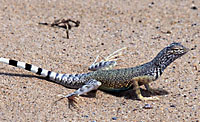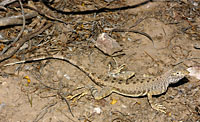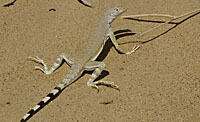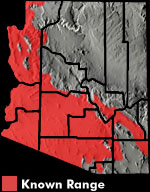Online Field Guide to The Reptiles and Amphibians of Arizona


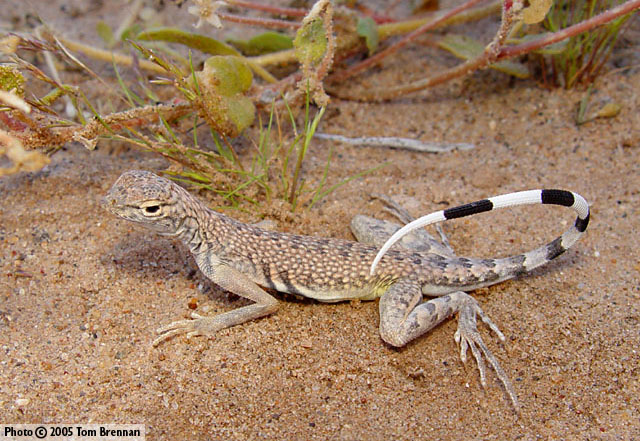
Yuma County, AZ
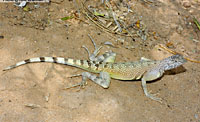 Yuma Co., AZ |
||
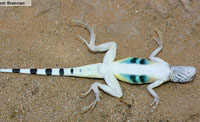 Maricopa Co., AZ |
| ZEBRA-TAILED LIZARD Callisaurus draconoides | |
|
DESCRIPTION: A medium-sized (up to 102 mm or 4″ from snout to vent), tan to yellowish tan lizard with long, slender limbs and a flattened tail. Two longitudinal rows of small gray-brown spots run down the middle of the back. The upper surfaces of the body are often marked with numerous cream spots or flecks. The back of each thigh is marked with a distinct, dark, horizontal line. The tail is marked with gray-brown bands that become black on the underside where they sharply contrast with the white background. The groin and lower sides are often tinted yellow. There are two dark bars on each side of the belly that extend up onto the sides just behind the forelimbs. On males the belly bars are surrounded by patches of blue and sometimes yellow and orange. A pink or peach spot often marks the throat. On females bars are faint or lacking. The body scales are small and granular. The external ear openings and forward position of its side bars distinguish this lizard from the similar looking Greater Earless Lizard. DISTRIBUTION: Distributed across nearly all of southwestern Arizona, our western borderlands, and our southeastern deserts. In our state it occurs at elevations ranging from near sea level along the Colorado River to about 5,000′. HABITAT: Flatlands within the Sonoran Desertscrub, Mohave Desertscrub, and Chihuahuan Desertscrub communities are favored haunts for this lizard. It is usually encountered areas with sandy soil and plenty of open space in which to run. Although it is most common in the flatlands it is also encountered in sandy washes within foothills and bajadas. BEHAVIOR: This heat tolerant diurnal lizard often remains active through mid-day when high temperatures force other lizards to seek shelter. It is occasionally encountered sleeping on the surface on warm nights. It hibernates underground during the cold months of winter and late fall. When approached by a predator it often curls and wags its tail over the back exposing the black and white “zebra stripes”. This may serve to let the predator know that it has been spotted by the lizard. If the predator knows it has been spotted it might not invest the energy required to chase this speedy lizard. The Zebra-tailed lizard runs with an explosive burst of speed. When fleeing it often runs with its tail curled over the back. This may be an effort to divert the predator’s attention to the tail (which can be regenerated). Both males and females are territorial and exhibit head bobbing, push-ups, and lateral compression of the body when outsiders approach. DIET: This lizard sits and waits for prey items to wander within close proximity. It feeds on a variety of insects including grasshoppers, bees, wasps, caterpillars, beetles, and ants. It also feeds on a variety of spiders, small lizards, and occasionally plant material. REPRODUCTION: The Zebra-tailed Lizard mates in spring and lays one or more clutches of eggs in summer. Clutch size ranges from 1 to 15 eggs. Hatchlings begin to emerge in July. By Thomas C. Brennan
Brennan, T. C., and A. T. Holycross. 2005. A Field Guide to Amphibians and Reptiles of Maricopa County. Arizona Game and Fish Department. Phoenix, AZ Stebbins, R.C. 2003. A Field Guide to Western Reptiles and Amphibians, Third Edition. Houghton Mifflin Company, Boston, MA. |
|
Visit Partners in Amphibian and Reptile Conservation:


HOME
Copyright © 2023, Arizona Game and Fish Department. All rights reserved.
If you make use of the textual contents of this site in reports, publications, etc. please cite and credit the author(s) and photographer(s). All photos on this website are copyrighted. However, those found in the species account section may be used for any noncommercial scientific, educational, or conservation purposes provided that photographs are not altered and continue to bear the copyright symbol and name of the photographer. Please contact the photographer regarding commercial use of copyrighted photographs.










